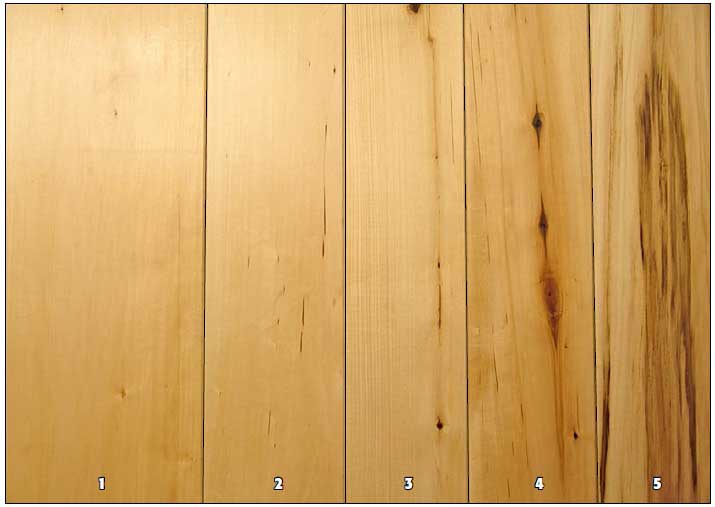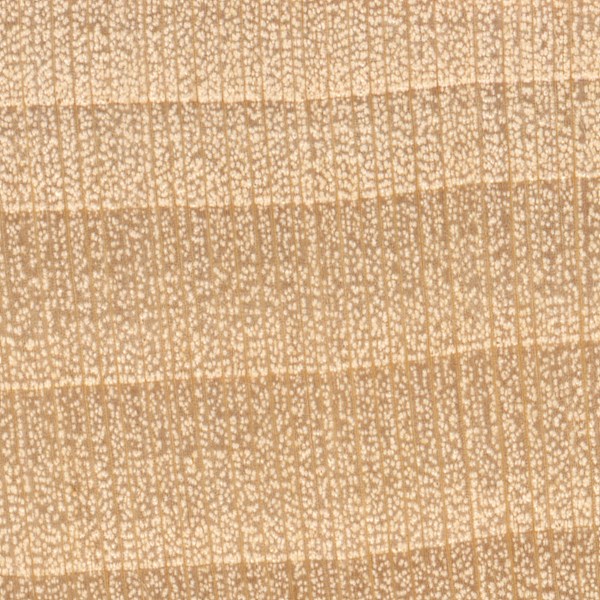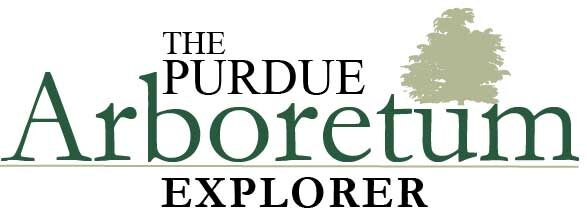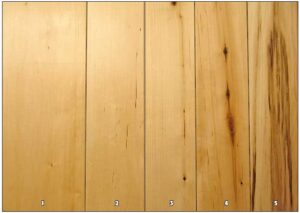Tilia Americana
Summary
Basswood is similar to the maples and ash in that it is the light-colored sapwood which is usually preferred. The color of the sapwood can vary from a very white color to a very light brown or flesh color.
Board 1 represents the best material the species has to offer. There is very little grain pattern, and the wood can be easily dented with a fingernail. Small brown pin knots are evident. Board 2 is lighter in color, but it contains what the industry calls mineral streaks or irregular light-brown streaks. These streaks are probably caused by an insect that bores in the cambium of the tree. The streaks are actually composed of pith cells that are very soft and formed by the tree as a response to injury. Board 3 is quarter sawn. Basswood is not commonly quarter sawn, but it will show a small ray fleck particularly if the inclusions in the rays turn brown which makes the ray tissue stand out. If the ray cells are clear, they are difficult to see. A section of the pith, or very center of the tree, is seen in the top two thirds of the board. Board 4 shows the brown heartwood of basswood and typical small knots and mineral streaks. Basswood is a wide sapwood species, and the amount of heartwood varies, often depending on the vigor and age of the tree. Older, slow-growth trees will have more heartwood. Board 5 shows a very heavy brown discoloration. This discoloration is often referred to as mineral. It is probably the result of damage to the tree or root system.
History
Basswood, also called linden, is an important species due to certain unique properties and uses. The tree ranges from the Great Plains east and from southern Canada through northern Arkansas, Kentucky, and the mountains of North Carolina and Tennessee. Three other varieties exist that extend the genus range south to central Florida and west to central Texas. Basswood prefers moist, deep, loamy soils and is found growing with many other species. Basswood is shade tolerant. Honey from basswood trees is prized in certain areas.
Basswood grows 70 to 80 feet tall and 2 to 3 feet in diameter. The largest tree reported is about 7.8 feet in diameter at 4.5 feet above the ground.
Color & Texture
The sapwood of basswood is white to creamy white or pale brown with a somewhat darker heartwood that may have a reddish tinge. Small black, brown to olive mineral streaks can occur. The wood is easily discolored by oxidation and fungal stain if not properly handled in the log and green lumber stage. The pores are evenly distributed and indistinct without a hand lens. The wood is considered fine textured. The rings are delineated by a change in poor size, and the rays are plainly visible on the quartered surface, especially on dark colored specimens. The wood has a faint, musty odor, especially when wetted.
Anatomical and Microscopy


Diffuse-porous; medium pores predominantly in radial multiples or clusters of 2-4; growth rings indistinct or distinct due to marginal parenchyma; medium to large rays, normal spacing, noded; parenchyma banded (marginal), apotracheal parenchyma diffuse-in-aggregates.
Wood Properties
- Workability
- In planing and boring, basswood is rated intermediate when compared to other commercial woods. In shaping and turning, basswood is rated toward the bottom of the list.
- Strength
- At 12% moisture content, the mechanical properties of basswood are relatively low, with the exception of bending properties and stiffness on account of the woods’ light weight.
- Steam Bending
- Basswood receives a very poor rating for steam bending.
- Drying
- Basswood is easily and quickly dried, and a severe drying schedule can be used.
- Shrinkage
- Shrinkage from the green condition is high and comparable to red oak. However, once the wood is dry, it tends to be stable.
- Decay
- No resistance to decay
Products
Basswood is rather plain looking and not particularly strong due to its light weight. It is easily nailed and tends to be stable once dried. Due to its light weight and stability, basswood is used for Venetian blind slats and key stock in pianos. Basswood is used for concealed parts in furniture, some millwork such as sash and doors, picture frame moldings, and for apiary supplies. It is also rotary peeled for core stock in plywood and basket veneer. Basswood is one of the most preferred species for carving. The wood is a poor choice where strength and hardness are needed.

